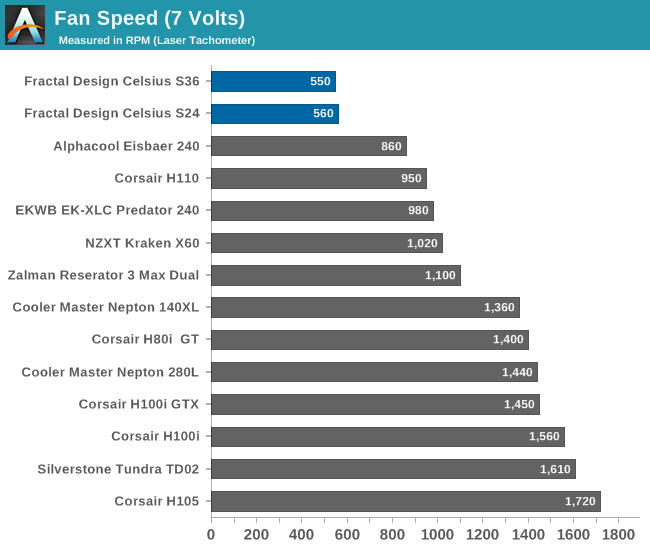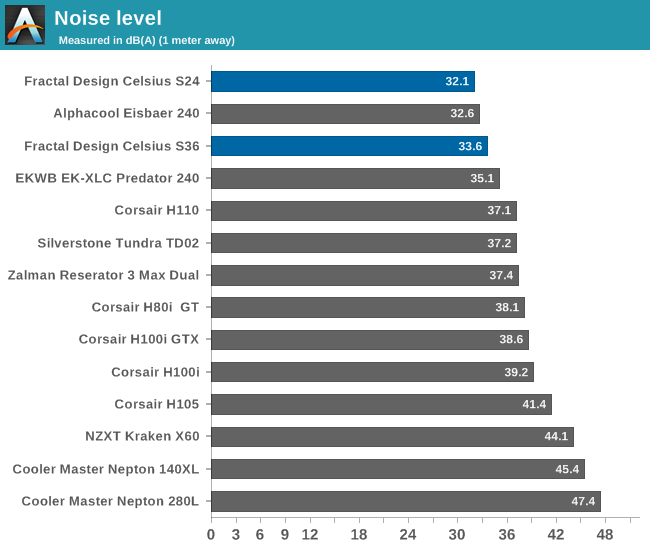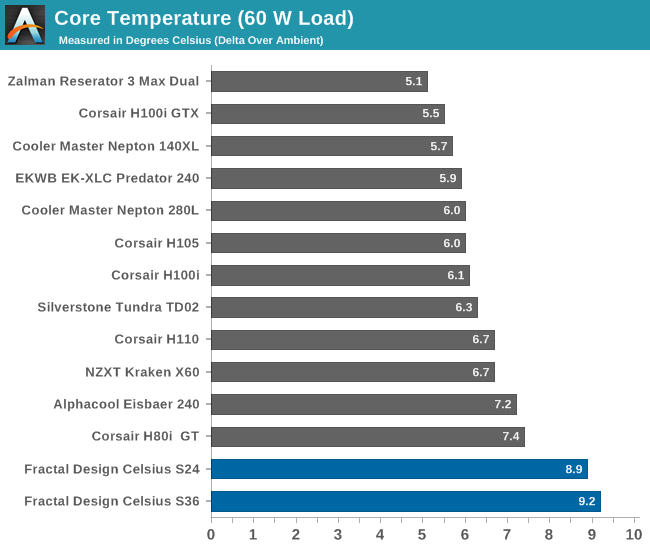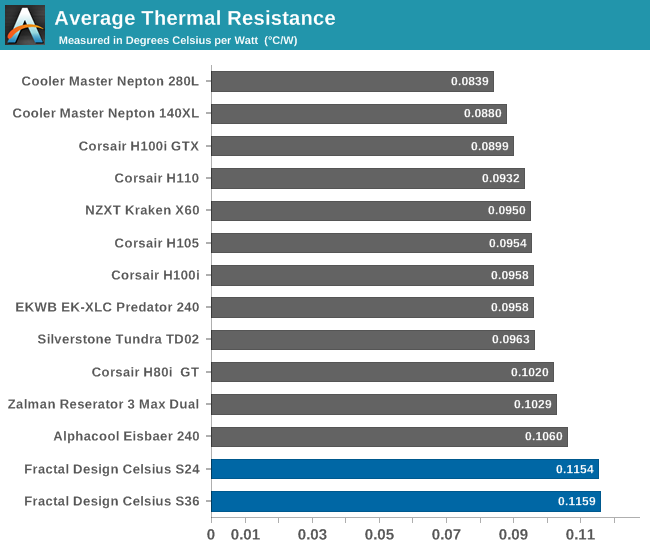The Fractal Design Celsius S24 & S36 AIO Coolers Review
by E. Fylladitakis on June 2, 2017 8:00 AM ESTTesting Results, Low Fan Speed
Before dissecting our low fan speed results, we should begin by noting that the design of the Celsius AIO coolers suggests that the fans will be powered by the cooler itself, from the hub on the radiator. With the whole assembly powered by a single cable, applying any fan speed control to the cooler will also affect the liquid pump as well. This particular pump does not react properly to a reduced voltage input, essentially requiring PWM control. Using a PWM voltage regulator, we reduced the speed of both kits down to their minimum operating point, which brought the speed of the fans down to 550-560 RPM.


The thermal performance of the Celsius kits with their fans and pumps driven down to minimum speed produced some very interesting results. Individually, the Celsius S24 displayed comparatively good thermal performance in conjunction with exceptionally low noise levels. The average thermal resistance of 0.1154 °C/W is mediocre when compared to that of other similarly sized coolers, but the sound pressure reading of 32.1 dB(A) is the lowest that we have recorded up to this date. Other recently released products could possibly rival the acoustics performance of the Celsius S24 if both the fans and the pump were driven via PWM controllers, but the Celsius series offers the convenience of concurrently driving everything via a single PWM signal/cable.

| Core Temperature, Constant Thermal Load (Low Fan Speed) |
However, the reduction of the pump’s speed alongside with the fans does not work as well for the larger version of the Celsius. The Celsius S36 not only did not perform significantly better than the S24 during this test, but it actually performed worse, especially at low load levels. Our assumption is that the small ceramic pump is not powerful enough to have its speed reduced that much and still be able to cope with the resistance of such a large radiator, meaning that the liquid flow was lowered to the point that outweighed the benefit of the greater heat exchange area. Regardless of equipment, measuring the flow without interfering with the factory configuration was all but impossible, so we cannot currently put our theory to the test. Nonetheless, irrespectively of the correct answer, the fact is that the Celsius S24 performs better than the large S36 with the speed of the pump and fans down to their minimum setting.











31 Comments
View All Comments
ratbert1 - Friday, June 2, 2017 - link
Please add a water cooled graphics card to the loop and see if it can cool both. That seems to be what these coolers are about.makerofthegames - Friday, June 2, 2017 - link
I was looking at these for a new build, because I might upgrade it to a custom cooling loop after a few years. An S36 would be a bit overkill for just a single consumer-grade CPU, but it would save the cost of a radiator if I upgrade. I'd still need a reservoir, GPU cooling block, and probably a pump, but it would at least save on the radiator.I might base my choice off what GPU I end up getting, since a long one would collide with the S36 in the case I'm using. And a radiator isn't that expensive, anyways.
nekronimus - Wednesday, October 18, 2017 - link
You could mount the S36 (pump) on the most popluar GPU using the kraken G12 GPU mounting kit. You could then buy a seperate CPU cooling block (50$) and reservoir and you're done. It's lot cheaper than mounting the S36 on the CPU and buying a seperate GPU cooler (starting 120$). Graphic cards are replaced more often than CPU's, so in the long run the first setup would also be way more cheaper, just by a new mounting kit and you're good to go.LawRecords - Saturday, June 3, 2017 - link
I'm building a new machine with a Phantek Evolv ATX case and the Celcius S24 cooler for the CPU. My GFX card is an air cooled Asus STRIX 1080 Ti. What is the best location of the radiator in that case, given that setup? I read somewhere that having the radiator at the top will be sub-optimal due to heat rising from the GFX card. Not sure if that's true. But regardless, where do you think will be best to minimize noise (want it as quiet as possible) for decent cooling?maximumGPU - Sunday, June 4, 2017 - link
you can always put it up top fans in pull rather than push. That way you won't take heat for your gpu, but more importantly (for me at least) you'd have positive air pressure in your case to keep dust out.To be honest though front or up won't make much difference in either temps (1-2 deg difference max) or noise, just go with whatever looks best to you and is easiest to install.
nekronimus - Wednesday, October 18, 2017 - link
Depends on how hot your 1080 Ti is running now. GPU's start throttling way faster than CPU's. I would avoid putting it in the front of your case, adding hot air to your GPU. Your CPU might run a degree or two colder but your GPU would have to endure an additional 3-5 degrees (depending on how well you airflow is through your case) whilst having less room before it starts throttling...sultan_khan - Sunday, June 4, 2017 - link
Please write on the following topicsAmazing Animated Gif Wallpapers-https://www.yourtechnocrat.com/gif-animated-wallpa...
PS3 Emulator android-https://www.yourtechnocrat.com/ps3-emulator-androi...
Linux OS For Android-https://www.yourtechnocrat.com/kali-linux-for-andr...
kushakizz - Thursday, June 8, 2017 - link
does the extra tube come with it for your video card...and if so all i have to do is buy a vc block riight and connect? or is there more to itJohnLinc - Tuesday, June 13, 2017 - link
thisistotesthedelayforwebTechEnthusiast - Friday, June 23, 2017 - link
Can we see real life scenarios now? I mean you've tested them using environments that nobody will use at home. Which is understandable if you want to achieve the maximum cooling capacity. But would like to see more normal examples on particular pc cases. I can also go to the north pole and see what temps i get there you know